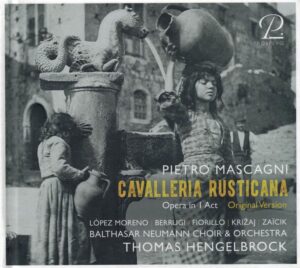
CD Review: Prospero Classical’s ‘Cavalleria Rusticana’
By Bob DieschburgThe record industry is at the forefront of modern musicology, digging up the original versions of long-established classics. In recent years, for instance, Opera Rara has paved the way with publications like the 1867 version of “Don Carlos,” “Simon Boccanegra,” and, in 2019, “Le Willis.”
The latter marks Puccini’s entrance onto the operatic stage and may reasonably be considered one of two foundational pieces of Italian verismo. The other is Mascagni’s “Cavalleria Rusticana” which the small label of Prospero Classical is releasing in its original, uncut shape for the very first time.
“Cavalleria” Uncut
Unlike the differences between Puccini’s “Le Willis” and his reworked, if not rebranded version of “Le Villi,” changes in the score of “Cavalleria Rusticana” are constitutive neither to the musical physiognomy of the opera nor to its structural makeup as a whole. Essentially, they fall within the limits of what can reasonably be considered as routine interventions in preparation of most late 19th century premieres.
As such, downward transpositions by half a step were meant to accommodate the singers whereas cuts to the arias and choir scene not only tightened the pace but also provided much needed relief to the Teatro Costanzi’s exceptionally ill-prepared choir – if one is to believe Mascagni’s frequent complaints to his wife, that is.
In practice, this means that some 247 measures or 11% of the original score were removed, not to mention the transposition of scenes like the “Preghiera” and the “Romanza.” Prospero Classical reverses the above changes; yet by no means does this unabridged “Cavalleria” spark the same interest as a rediscovered “Don Carlos” or even “Le Willis.”
Differences to the established score are superficial for the most part and likely to charm the most entrenched philologists only. Unlike “Le Willis,” for instance, the original “Cavalleria” gives few, if any, new insights into the rather spontaneous development of the verismo subgenre in the 1890s.
This does not mean, however, that the present release is without its appeal; on the contrary, it benefits from the sophisticated conducting of Thomas Hengelbrock whose quasi-symphonic attention to detail makes the score unusually prismatic and colorful.
Under his baton, the Balthasar Neumann Orchestra sets the tone for a poetic, if slightly un-Italianate rendition, which extracts Mascagni’s harmonious language rather than dramatic content.
López Moreno on the Rise
Possibly the biggest asset to the current album is the Bolivian-Albanian Carolina López Moreno. It is unusual for labels to cast the role of Santuzza as a soprano; yet the dark-hued timbre of López Moreno’s instrument has no less depth than a full-fledged mezzo.
She is fiery, sensual, and fragile at will; in terms of vocal physiognomy she is some sort of Carmen-in-disguise whose lush tones may at times cover up the delicacy of her mezza voce, as when her “sono scomunicata” is nothing but a heart-wrenching wail.
No doubt López Moreno has all the resources to break into the spinto repertory of other verismo characters, let alone both Leonoras from the peak of Verdi’s very own brand of Romanticism. On YouTube, enthusiasts will find plenty of the young soprano’s art to go back to over and over again.
Her Turiddu is none other than Giorgio Berrugi who was scheduled to make his Met debut in 2020. The sharpness of his timbre matches the impetuosity of the Sicilian protagonist; yet the vulnerability of the character persists throughout. In the confrontational duet with Santuzza, for instance, angry outbursts alternate with the plaintive, if not reproachful attempt to drive her away (“perché seguirmi, perché spiarmi”).
Slovenian-born baritone Domen Križaj lends his voice to the carter Alfio; stylistically sophisticated, his Alfio boasts a warm and mellow tone which is luxurious yet a tad tame for a violently jealous husband.
One gains the impression the Romantic repertory is really at the heart of Križaj’s vocal inclinations. The verismo genre may be a tangential addition which, in “Cavalleria Rusticana,” he infuses with unwonted finesse.
Atypically Veristic
The main cast is supported by Elisabetta Fiorillo and Eva Zaïcik in the roles of Lucia and Lola respectively. Zaïcik makes an unexpected appearance as she is most readily associated with the Baroque period.
The Balthasar Neumann Chorus is being put to the test in the extended “Preghiera.” It does not have the incisiveness of a true Italian chorus nor does it provide as much of a sympathetic background to the protagonists as one may expect from established recordings of “Cavalleria.”
Instead, it contributes to the overall feeling that the current release is somewhat atypical; it presents the score in its original form, with most cuts and transpositions reversed, while both the orchestra and the chorus are not attuned to the veristic soundscape properly speaking.
This is not for the worse, however, as the main cast is delightful, sometimes brilliant with, above all, the lyrically inspired Santuzza of Carolina López Moreno. It is for her rather than for the salvaged 11% of the score that Prospero Classical’s “Cavalleria” is worth a try.


